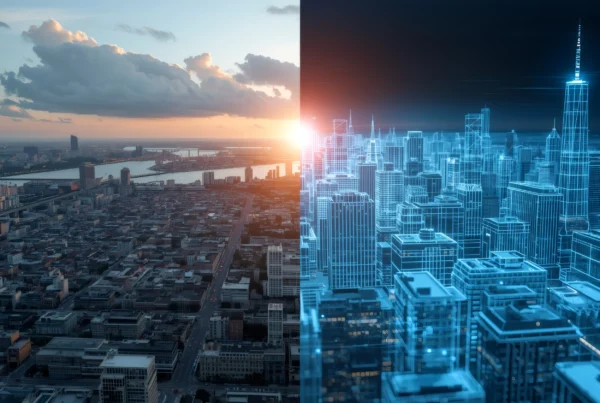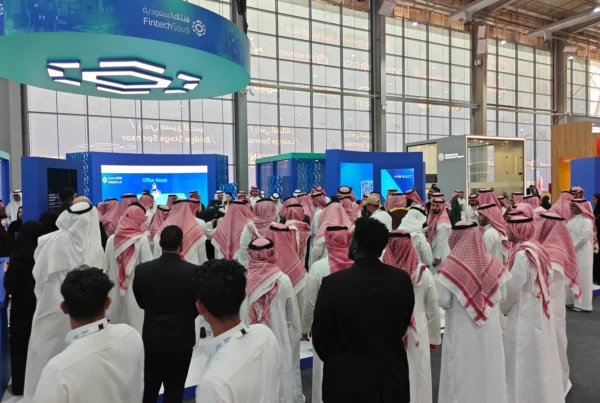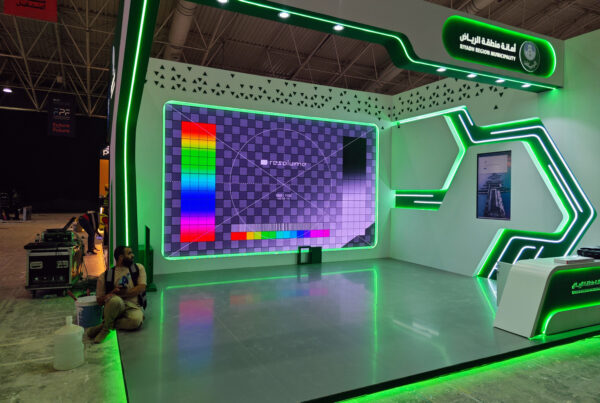How Banque Saudi Fransi turned banking into hands-on, two-minute stories with a Tangible Table and a giant Mobile App Explorer built for the pace of Money20/20 Middle East.
Money20/20 is where fintech stories need to land fast. At the Riyadh edition, we helped Banque Saudi Fransi (BSF) translate complex products and mobile journeys into clear, interactive experiences built for a high-traffic show floor. Our solution paired two stations that work in tandem: a Tangible Table a token-based, Monopoly-style “board” for exploring BSF’s products and a towering Mobile App Explorer that plays like an oversized phone, guiding visitors through real app use cases.
This is the behind-the-scenes account of how we designed the booth flow, engineered reliability, and coached a repeatable two-minute story that created momentum in every conversation. If you’re planning your own interactive banking presence at a major forum like Money20/20, consider this your field guide.
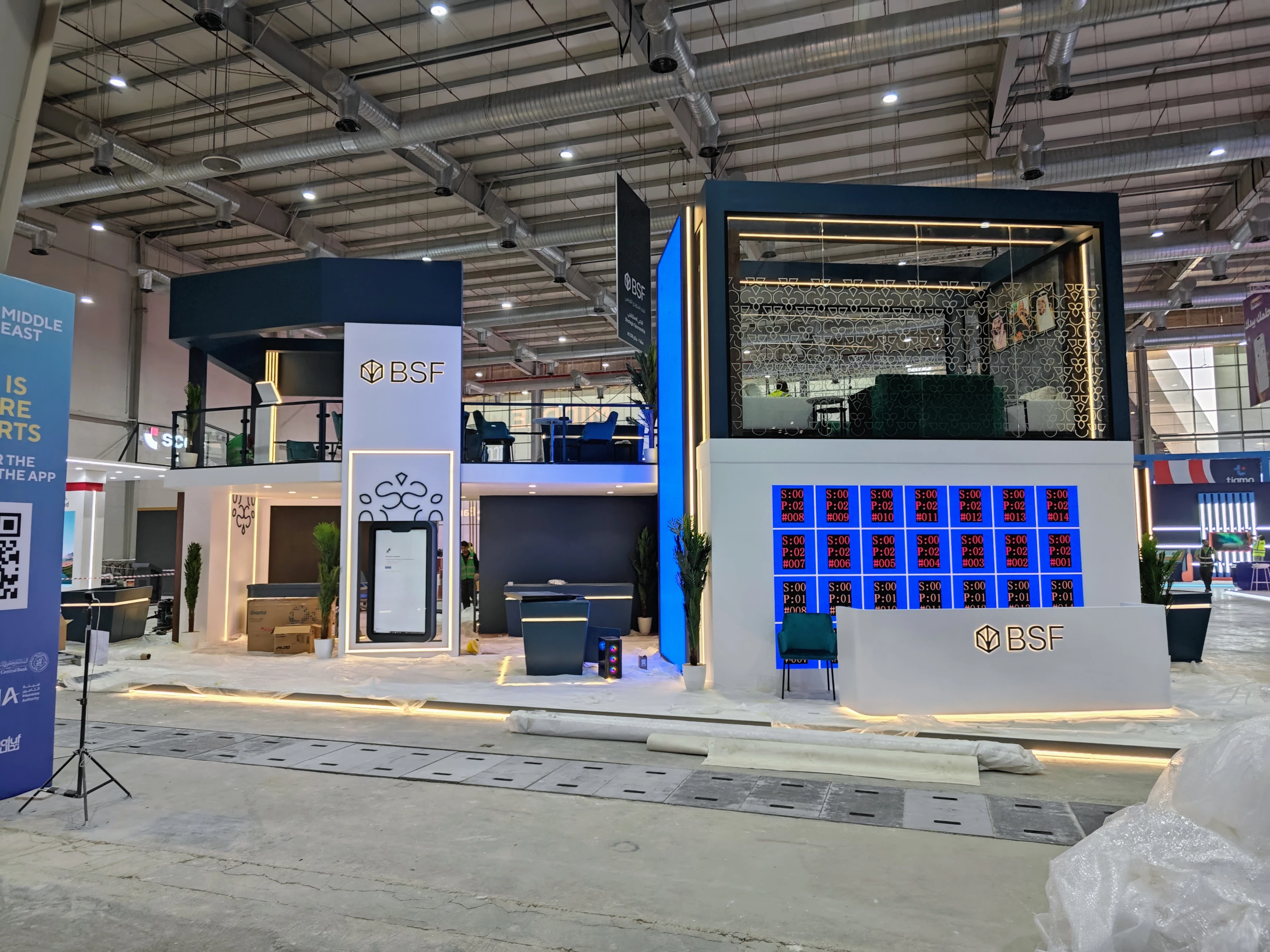
Why Interactive Banking Wins at Money20/20
Big shows reward clarity and pace. Attendees form impressions in seconds, skim visuals from a distance, and only stop when the experience promises something new. For banks, that means moving beyond static slides to experiential technology that visitors can feel, see, and navigate without instructions.
At a macro level, we design every booth around a simple customer journey: attract → interact → hand-off. That structure focuses attention and makes the sales team’s job easier. If you’re mapping your own show-floor journey, our deep-dive on frictionless flow is a helpful primer: Customer Journey Mapping for Experiential Events.
The second principle is visual legibility. Trade-show halls are bright, busy, and full of competing screens. You need a hero surface that’s readable from 15–20 meters and an interaction that’s understandable at a glance. We often call this the “stop-and-scan” moment people look, understand what to do, and step closer.
Finally, the experience must be high-throughput. Demos should last 90–120 seconds and end with a clear hand-off to the team. That rhythm keeps the queue moving and steadily converts curious passersby into qualified conversations.
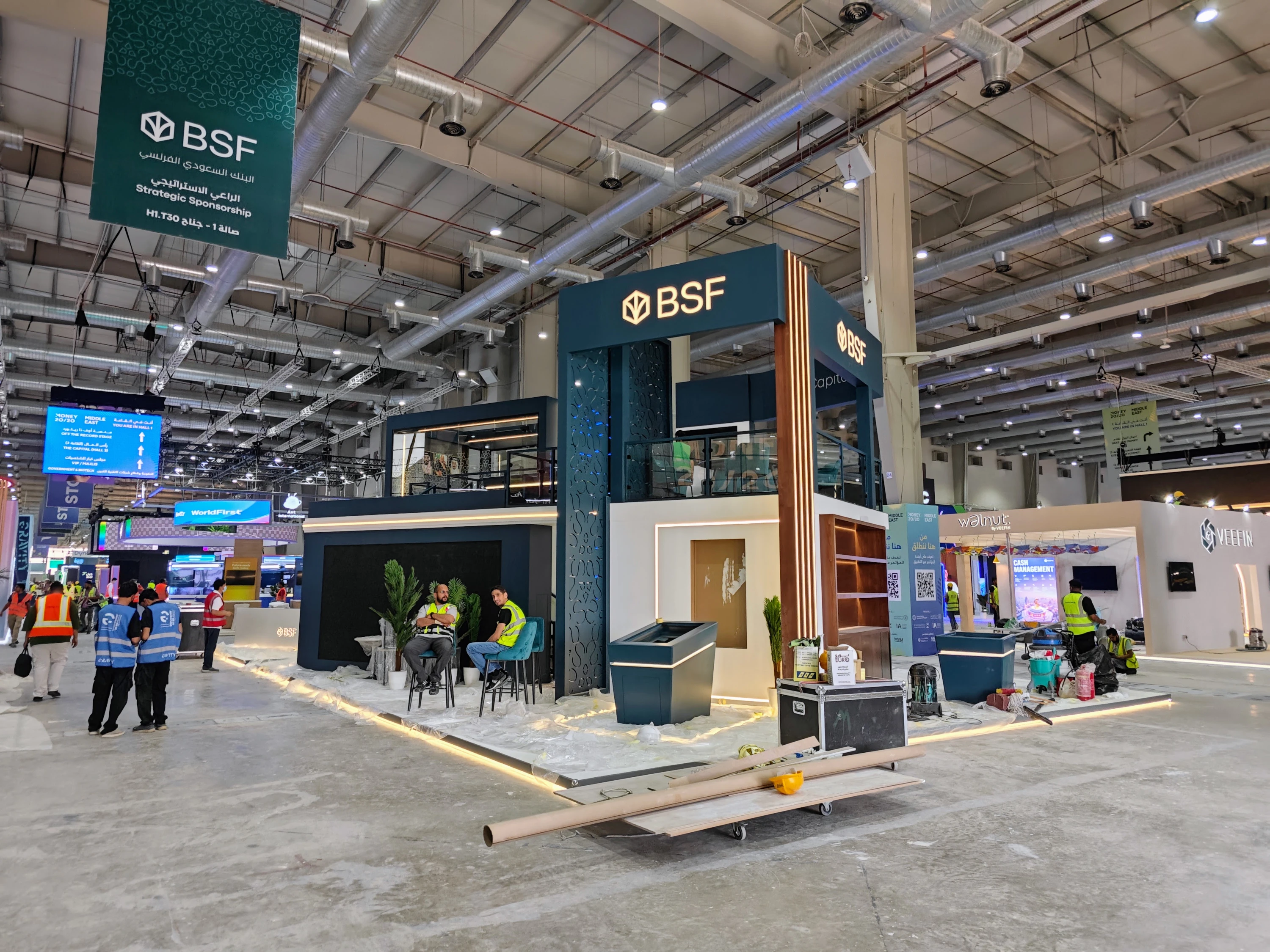
Two Stations, One Story: Tangible Table + Mobile App Explorer
For BSF we proposed a paired concept: two different interactions that tell one story from two angles what BSF offers (products) and how customers use it (mobile journeys).
The Tangible Table
Imagine a modern, polished game board. Visitors pick up machined metal tokens and place them on the table. Each token represents a product theme retail accounts, cards, SME financing, and so on. When a token touches the surface, the table recognizes it and launches a focused path: a few crisp screens that state the customer problem, the value, and the next step. The tactile action turns abstract features into a mini-narrative people remember.
The Mobile App Explorer
Next to the table stands a dramatic, giant vertical screen styled like an oversized smartphone. It’s calibrated to look great on camera and across the hall. Guests tap through real use cases onboarding, daily banking, payments and see the core steps without clutter. This station answers the “how will I experience it?” question in seconds.
By splitting the story across two stations, we keep queues flowing and let different personalities self-select: some prefer a playful, social interaction; others want to “drive the phone.” Together, they create a neat attractor loop: table → screen → conversation at the meeting counter.
If you want a broader foundation in the underlying methods, our primer Immersive Solutions 101 covers why hands-on formats outperform static exhibits.
Designing the Tangible Table: Token-Based Banking
The Tangible Table borrows a familiar language tokens on a board so it’s instantly understandable. Under the hood, the recognition layer maps each token to a product storyline. We structure each storyline as a tight sequence:
-
Context – A one-line “why this matters” in plain language.
-
Moment of Value – The aha (e.g., “real-time alerts,” “instant issuance,” “fees explained”).
-
Proof – A succinct detail, stat, or example.
-
Next Step – A conversational prompt: “Want to see this in the mobile app?”
Because the table is tactile and collaborative, it’s naturally social people lean in, compare tokens, and discuss. That creates space for the team to qualify interest without interrupting the flow. We target 90–120 seconds per interaction, which keeps the queue moving while enabling multiple tokens in a single conversation.
From a production standpoint, this format re-skins beautifully. Tokens can be grouped by audience (retail vs. SME) or by theme (payments, lending, day-to-day banking). If you’re planning a roadshow, reusability matters for budget and speed.
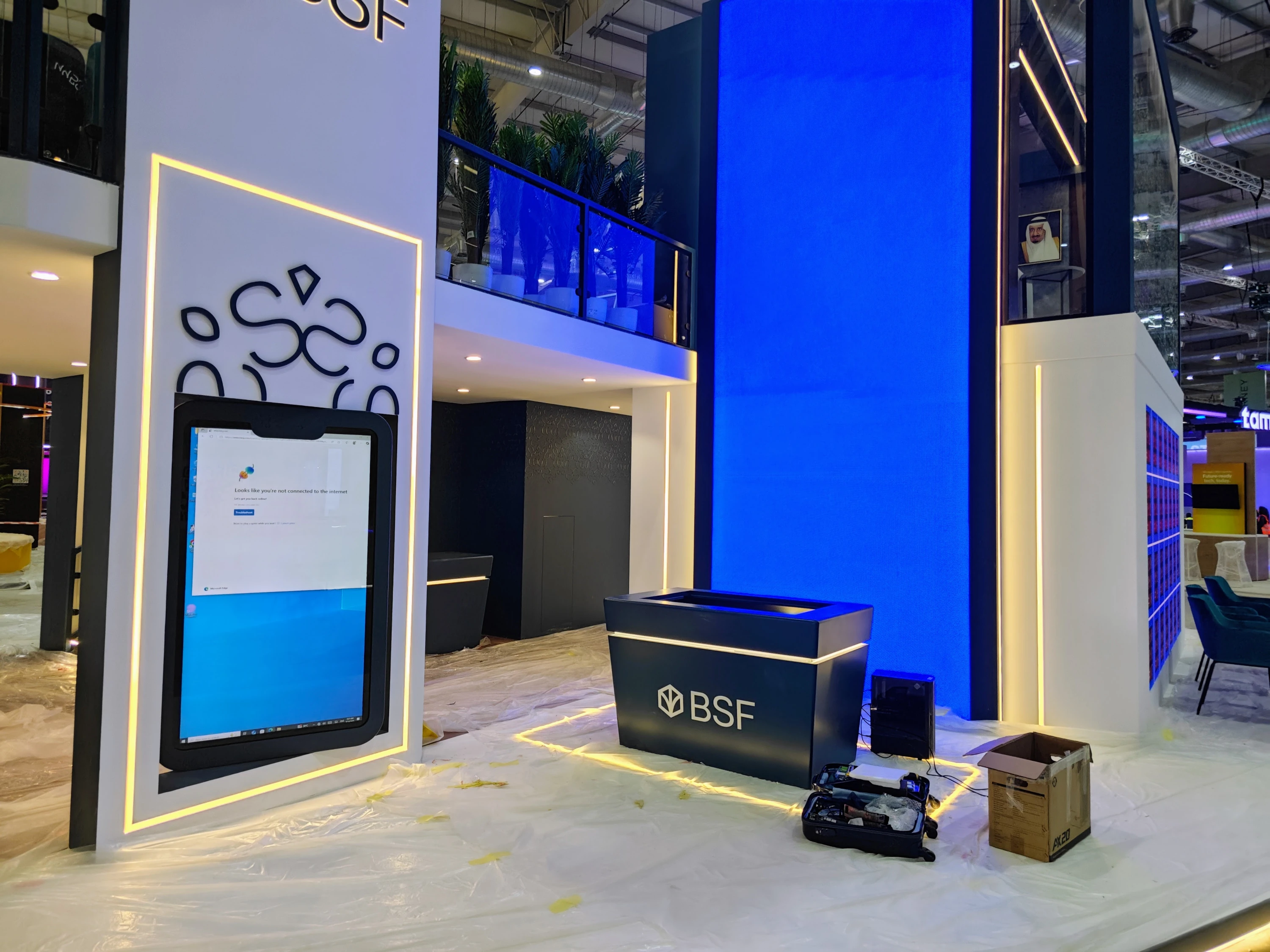
Building the Giant Mobile App Explorer
On the right, the Mobile App Explorer operates like a stage: a tall, portrait LED wall stylized as a phone and framed with clean lighting. It anchors sightlines and gives the booth a strong vertical signature isitors can spot it from afar and film it easily.
We curate a use-case tree that mirrors how real customers discover value:
-
Opening an account
-
Viewing balances and transactions
-
Paying bills and transferring money
-
Card management (limits, freeze, alerts)
-
SME tasks (invoicing, approvals)
Each use case is a short, guided path. We favor plain language, focus on the “why,” and avoid compliance or legal copy on the big screen; those details belong in follow-up materials.
Because the event is in Riyadh, we designed Arabic-first with optional English. Bilingual UI choices should feel native, not bolted on icons, spacing, and line length all change slightly when optimizing for Arabic. For teams exploring similar designs, our overview on building trust into interactive surfaces Digital Humans 101: Designing an AI Avatar Kiosk that Customers Trust outlines practical UX decisions that increase comfort and credibility on a busy show floor.
Under the Hood: Unreal Engine for Smooth, Camera-Ready Demos
We build kinetic booth content in Unreal Engine because it gives us cinematic motion with reliable frame pacing two attributes that matter when people are filming on their phones and sharing clips instantly. If you’re evaluating tech stacks, start with the official Unreal Engine documentation to see how real-time rendering pipelines support large displays and low latency.
For BSF, our checklist focused on event hygiene:
-
Pre-baked camera moves that read clearly on a tall portrait display.
-
LOD and streaming discipline to keep the GPU cool under continuous duty.
-
Material simplification for bright halls prioritize silhouette and legibility over subtle shader micro-details.
-
Presenter presets (bookmarks) so operators can jump instantly to “Payments,” “Onboarding,” or “SME.”
-
Thermal and power safeguards: stress-tested workstations, tidy cable runs, and a small UPS for graceful shutdowns.
We also calibrated color and brightness against the venue light levels. If you’ve ever battled crushed blacks or blown highlights on LED in a bright hall, you’ll appreciate the tips in our display guide: How Projection Mapping & LED Screens Handle Content.
Reliability: The “Boring Stuff” That Wins Deals
Great ideas fall flat if the demo jitters, the tablet drops its connection, or the system needs a reboot during a VIP walkthrough. Reliability is a product feature.
Our daily routine at Money20/20 included:
-
Cold boot before doors to verify startup time and asset integrity.
-
Network health checks for control devices.
-
Content freeze 24 hours before opening no last-minute swaps unless critical.
-
Shadow-operator station near the workstation to reset scenes, support the team, and hot-swap if needed.
-
Mirrored drives and a hot-swap image so worst-case recovery would be measured in minutes.
These habits come from running complex interactive solutions at scale. If you need a wider sense of how we package event tech end-to-end from scoping and content to on-site ops our overview page Smart Interactive Solutions outlines the building blocks.
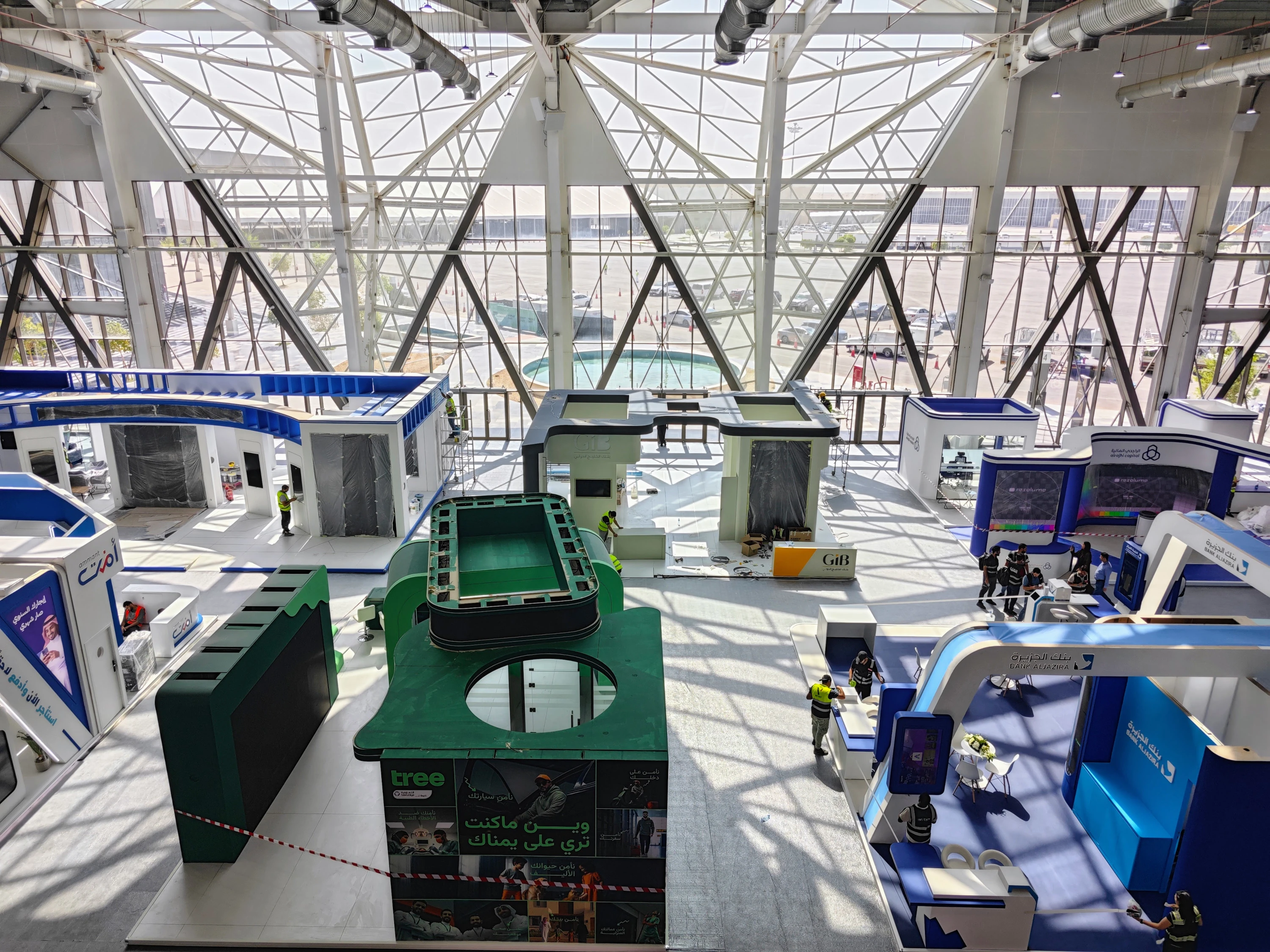
Scheduling in KSA: Mind the Week
Planning in Saudi Arabia? Logistics make a difference. The standard Saudi working week is Sunday to Thursday, with Friday and Saturday as the weekend. We outline the practical implications for install windows, rehearsal time, and crew rotations in How Saudi Arabia’s Sunday–Thursday Workweek Impacts Global Business Relations. The short version: don’t lose your only rehearsal to a weekend mismatch. Coordinate venue handovers around the local rhythm, and your first VIP tour will feel composed not rushed.
Lessons You Can Steal for Your Next Booth
If you’re planning an interactive banking presence at a major fintech forum, here’s a compact 7-step playbook:
-
Decide the story first.
Pick three conversation archetypes (retail, SME, corporate). Script a two-minute path for each. -
Split story across stations.
One station answers “what we offer,” another answers “how it works.” It doubles capacity and improves comprehension. -
Design for high throughput.
Build 90–120s interactions. Anything longer is a white-glove demo, which belongs in a meeting room. -
Make it filmable.
Stabilize motion, avoid flicker, and compose frames that look good on phones people will share them. -
Engineer reliability.
Mirrored drives, hot-swap images, clean power, and a small UPS. You’ll never regret redundancy. -
Train for the hand-off.
End every demo with a question and an invitation: “Want a deeper walkthrough?” Then walk them to the desk. -
Measure what matters.
Track throughput and qualified meetings. Those two numbers are your ROI backbone.
For more context on tools, thresholds, and tactics we use across immersive environments, this long-form primer is a good companion read: Immersive Solutions 101.
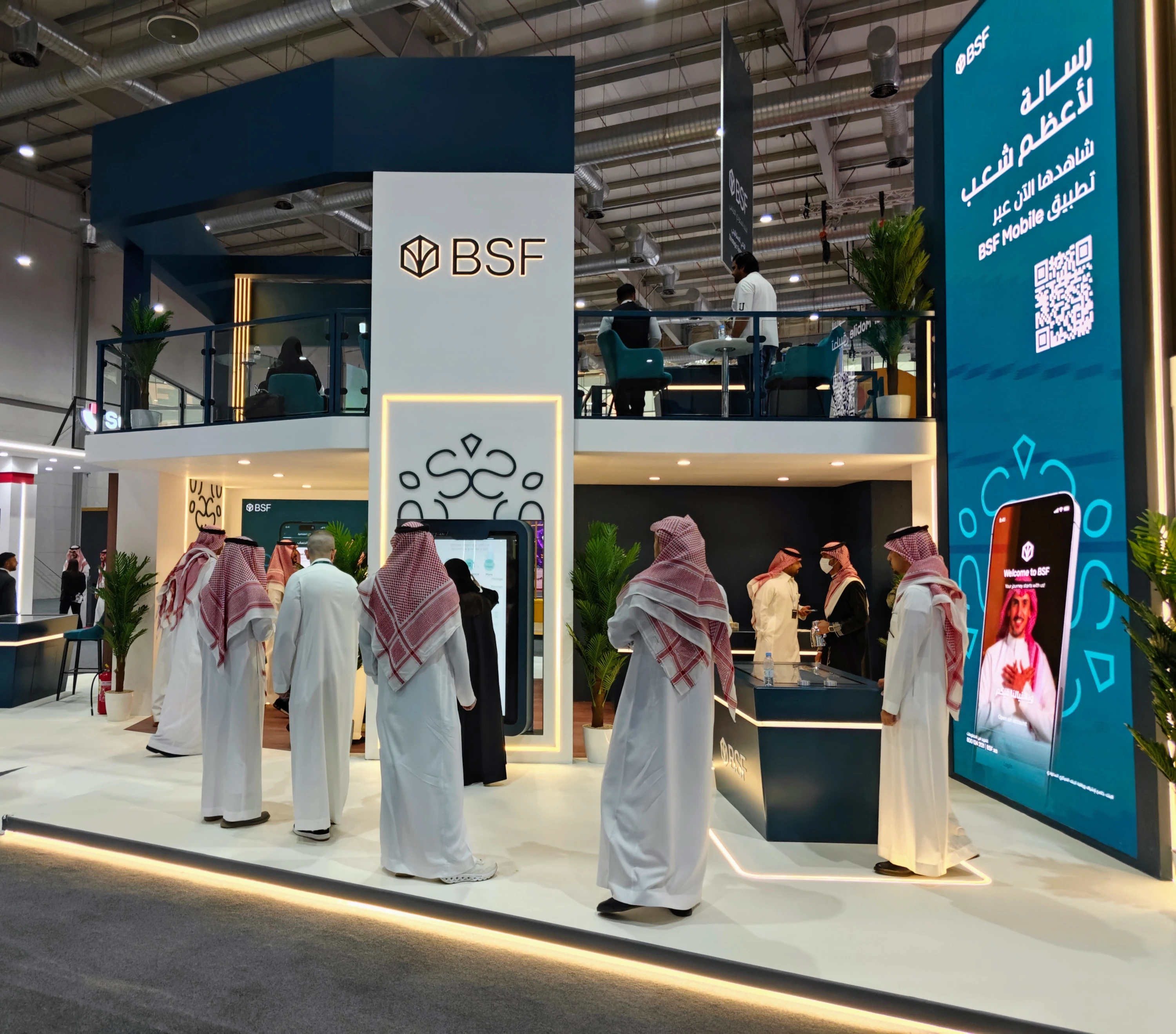
Planning Something Similar?
If you’re mapping an interactive presence for a fintech forum or national pavilion, you don’t need to reinvent your whole product story. You need one tactile hook, one clear hero screen, and a two-minute script your team can deliver on repeat. We package these elements as part of our end-to-end offer scoping, design, Unreal content, hardware, and on-site ops. Explore the building blocks on Smart Interactive Solutions, then reach out when you’re ready to adapt the format to your goals.
To time your rollout around the industry calendar and related showcases in KSA, keep an eye on event hubs like Money20/20 and regional forums. And if you’re designing a multi-surface environment LED walls, portals, or mirrored floors our extended practice across urban and real-estate showcases (for example, the Riyadh Digital Twin at Future Projects Forum) shows how to keep content legible and operations calm even when the stage gets ambitious.
Frequently Asked Questions
Do we need Pixel Streaming for a booth like this?
Not necessarily. For an on-site forum with a local display chain, a workstation provides the lowest latency and best reliability. Pixel Streaming shines when you need remote access or post-event demos.
Can we add AI or avatars later?
Yes. We often start with simple, high-throughput interactions and later layer on conversational helpers or guided explainers as the content matures. If building trust around kiosk interactions is on your roadmap, see Designing an AI Avatar Kiosk that Customers Trust.
How long does a build like this take?
Lead times vary by content complexity and hardware availability. The fastest path is to lock the story early, keep the UI plain, and reuse modular assets for multiple shows.
Where can I learn more about BSF?
Visit the bank’s official site to see the broader context of their services: Banque Saudi Fransi.
